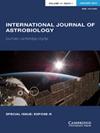铁还原是土卫二海洋中可行的代谢途径
IF 1
4区 物理与天体物理
Q3 ASTRONOMY & ASTROPHYSICS
引用次数: 1
摘要
最近的研究假设了土卫二海洋中一系列代谢途径的可行性,这些代谢途径是由探测到的羽流中的H2和CO2驱动的——这是由土卫二海底热液活动驱动的甲烷生成的可用自由能量的证据。然而,这些尚未被详细探讨。在这里,进行了一系列实验来研究微生物铁还原是否可能是海洋中铁还原细菌(如硫还原地杆菌)的一种可行的代谢途径。这项研究有三个主要结果:(i)使用醋酸盐作为电子供体,预测在土卫二上存在的一些含铁(III)矿物晶体的成功还原被证明在不同程度上发生;(ii)分别使用乙酸和H2(g)作为电子供体,证明了细菌在模拟的Enceladus海洋培养基中可以大量生长;(iii)水合铁的微生物铁还原部分发生在目前公认的土卫二海洋pH值为9时,而在环境海洋温度为0°时则严重受阻。这项研究提出了土卫二海洋中生物地球化学铁循环的可能性,表明一种铁还原细菌可以在类似土卫二的条件下有效地发挥作用。本文章由计算机程序翻译,如有差异,请以英文原文为准。
Iron reduction as a viable metabolic pathway in Enceladus’ ocean
Recent studies postulated the viability of a suite of metabolic pathways in Enceladus’ ocean motivated by the detection of H2 and CO2 in the plumes – evidence for available free energy for methanogenesis driven by hydrothermal activity at the moon's seafloor. However, these have not yet been explored in detail. Here, a range of experiments were performed to investigate whether microbial iron reduction could be a viable metabolic pathway in the ocean by iron-reducing bacteria such as Geobacter sulfurreducens. This study has three main outcomes: (i) the successful reduction of a number of crystalline Fe(III)-bearing minerals predicted to be present at Enceladus was shown to take place to differing extents using acetate as an electron donor; (ii) substantial bacterial growth in a simulated Enceladus ocean medium was demonstrated using acetate and H2(g) separately as electron donors; (iii) microbial iron reduction of ferrihydrite was shown to partially occur at pH 9, the currently accepted value for Enceladus’ ocean, whilst being severely hindered at the ambient ocean temperature of 0°. This study proposes the possibilities for biogeochemical iron cycling in Enceladus’ ocean, suggesting that a strain of iron-reducing bacteria can effectively function under Enceladus-like conditions.
求助全文
通过发布文献求助,成功后即可免费获取论文全文。
去求助
来源期刊

International Journal of Astrobiology
地学天文-地球科学综合
CiteScore
3.70
自引率
11.80%
发文量
45
审稿时长
>12 weeks
期刊介绍:
International Journal of Astrobiology is the peer-reviewed forum for practitioners in this exciting interdisciplinary field. Coverage includes cosmic prebiotic chemistry, planetary evolution, the search for planetary systems and habitable zones, extremophile biology and experimental simulation of extraterrestrial environments, Mars as an abode of life, life detection in our solar system and beyond, the search for extraterrestrial intelligence, the history of the science of astrobiology, as well as societal and educational aspects of astrobiology. Occasionally an issue of the journal is devoted to the keynote plenary research papers from an international meeting. A notable feature of the journal is the global distribution of its authors.
 求助内容:
求助内容: 应助结果提醒方式:
应助结果提醒方式:


